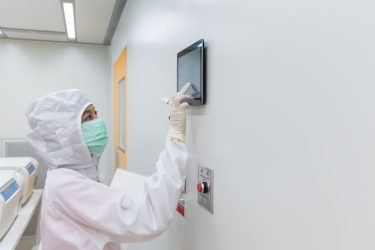
What are the biggest environmental monitoring trends shaping the industry?
The introduction of rapid microbiological testing methods, such as biofluorescent particle counters for real time detection of microbial contamination, has had an important impact on cell and gene therapy manufacturing.
There is a limited time frame between manufacture and administration that does not allow for traditional sterility testing seen in other types of pharmaceutical manufacturing. Real-time detection of microbial contamination, especially in autologous cell and gene therapy manufacturing, is a critical step forward in assuring the safety of autologous products.
Another advance is the use of virtual reality (VR) modelling of operational areas for environmental monitoring location mapping of cleanrooms. The use of VR modelling of cleanrooms and equipment layouts gives the ability to visualise the manufacturing activities and their proximity to critical areas. This enables the early development of risk-based environmental monitoring programmes in preparation for Performance Qualification activities.
The introduction of Internet of Things (IoT) technology, using the internet to link networks of sensors, devices and systems with cleanroom monitoring systems, is set to change how data from cleanroom monitoring sensors is used. It can enable data integration and analysis of environmental and operational data in real time, leading to improvements in cleanroom operations and maintenance and, ultimately, product safety.
How is eXmoor navigating these advances in the sector?
eXmoor uses advanced 3D modelling including detailed layouts as part of the clean room design process. These models can be used to support the environmental monitoring location mapping. It would be a short step to introduce a VR model to allow the operators to ‘walk’ through the process to identify critical locations for environmental monitoring plates.
The company’s environmental monitoring system is wireless, with cloud-based data collection and storage. This is the first step towards the use of IoT technologies to enhance the management and maintenance of our cleanrooms.
Can you share an example of a challenge eXmoor faced when setting up the environmental monitoring system in its GMP manufacturing cleanrooms at its Cell and Gene Therapy Centre? What were the solution?
The biggest challenge was finding an environmental monitoring system with monitoring probes that could be located flexibly, and that could be extended as new equipment and clean rooms are brought on line for continuous equipment environment monitoring. A wireless-based monitoring system that can be extended and fitted without ‘breaking into’ the clean room fabric was the solution.
What were the most important aspects eXmoor chose to include in the contamination control strategy for its GMP manufacturing cleanrooms?
As a multi-product CDMO, the contamination control strategy (CCS) for eXmoor focused on controls for the prevention of contamination and cross-contamination. The development of the CCS began very early on at the design stages, taking into account the facility design objectives. These included a cell and gene therapy facility for multiple clients and multiple processes operating simultaneously, as well as design processing modules for GMP manufacture ranging from small-scale autologous to a maximum viral vector scale of 2 x 200 litres.
The use of a wireless solution for environmental monitoring of equipment has been essential to future-proof the [manufacturing] facility”
We analysed 12 candidate processes to determine room sizes and ensured segregation for each process module, with a maximum room classification of Grade C. In terms of clean rooms, it was important to provide a rapid expansion strategy and capability to meet market needs, with expandable utilities to meet increased manufacturing requirements.
The operational CCS evolved into a detailed set of operational risk and impact assessments covering all aspects of the GMP operations, from the introduction of materials through the warehouse into the GMP areas and clean rooms, personnel movements, product movements.
What measures has eXmoor put in place to ensure its environmental monitoring system is ready for future facility expansion and advances in the sector?
The use of a wireless solution for environmental monitoring of equipment has been essential to future-proof the facility. In addition, as the use of rapid microbiological monitoring becomes more acceptable and robust, eXmoor would look to introduce the technology to its environmental monitoring programme. For now, however, the requirements of EU GMP Annex 1 still require the use of traditional methods of microbial monitoring.
About the interviewee
 Gill Lewis is Associate Director GMP & QP and Chief GMP Consultant at eXmoor Pharma. She is an EU qualified QP and provides GMP compliance oversight to all of eXmoor’s projects. Her experience combining operational and capital projects makes her ideally suited to evaluating technologies and manufacturing processes, assisting with process and analytical development and ensuring GMP compliance during capital projects and operational manufacturing units.
Gill Lewis is Associate Director GMP & QP and Chief GMP Consultant at eXmoor Pharma. She is an EU qualified QP and provides GMP compliance oversight to all of eXmoor’s projects. Her experience combining operational and capital projects makes her ideally suited to evaluating technologies and manufacturing processes, assisting with process and analytical development and ensuring GMP compliance during capital projects and operational manufacturing units.
The post Advancing environmental monitoring systems for CGT manufacturing appeared first on European Pharmaceutical Review.

